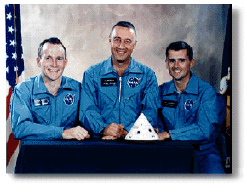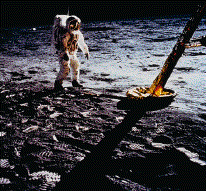EXPLORATION
 |
 |
 |  |
 |
 |
 |

 This page is dedicated to those who have dared to reach for the stars. You will never be forgotten.
This page is dedicated to those who have dared to reach for the stars. You will never be forgotten.
 Above, astronauts Jarvis, Mcauliffe, Mcnair, Onizuka, Resnick, Scobee, and Smithm.
Above, astronauts Jarvis, Mcauliffe, Mcnair, Onizuka, Resnick, Scobee, and Smithm.
 Left, astronauts White, Grissom, and Chaffee.
Left, astronauts White, Grissom, and Chaffee.

 Man has always wanted wanted to explore space and in 1959 the National Aeronautics and Space Administration (NASA) selected seven individuals to be our first astronauts.
Man has always wanted wanted to explore space and in 1959 the National Aeronautics and Space Administration (NASA) selected seven individuals to be our first astronauts.
 Project Mercury and project Gemini were our first human space programs and they were mainly concerned with getting a spacecraft to orbit the Earth, having the humans beings aboard survive, and bringing the spacecraft safely back to Earth.
Project Mercury and project Gemini were our first human space programs and they were mainly concerned with getting a spacecraft to orbit the Earth, having the humans beings aboard survive, and bringing the spacecraft safely back to Earth.

 The Apollo program began in 1961 and its mission was to land a spacecraft on the Moon. After many years of preparation and test flights, astronauts Neil Armstrong, Michael Collins and "Buzz" Aldrin landed on the Moon (July 1969, Apollo 11).
The Apollo program began in 1961 and its mission was to land a spacecraft on the Moon. After many years of preparation and test flights, astronauts Neil Armstrong, Michael Collins and "Buzz" Aldrin landed on the Moon (July 1969, Apollo 11).
 Since that historic moment, we have continued to have other spaceflight programs (Skylab, Apollo-Soyaz and the Space Shuttle) but we have never again landed humans on any other planet or object.
Since that historic moment, we have continued to have other spaceflight programs (Skylab, Apollo-Soyaz and the Space Shuttle) but we have never again landed humans on any other planet or object.
 We have continued to send unmanned space vehicles (probes) to view the Solar System and land on other planets. Some of their names are Mariner, Pioneer 10 and 11, Viking 1 and 2, Pioneer Venus 1 and 2, Voyager 1 and 2, Magellan, Galileo, Explorer, Ranger, Surveyor, Lunar Orbiter, and Clementine.
We have continued to send unmanned space vehicles (probes) to view the Solar System and land on other planets. Some of their names are Mariner, Pioneer 10 and 11, Viking 1 and 2, Pioneer Venus 1 and 2, Voyager 1 and 2, Magellan, Galileo, Explorer, Ranger, Surveyor, Lunar Orbiter, and Clementine.

 In recent years, the Hubble Space Telescope has given us some of the most fantastic images of space that we have ever had.
In recent years, the Hubble Space Telescope has given us some of the most fantastic images of space that we have ever had.
 If you have an interest in the Hubble Telescope, please visit the Hubble Telescope Home Page. Everything you ever wanted to know about it will be there.
If you have an interest in the Hubble Telescope, please visit the Hubble Telescope Home Page. Everything you ever wanted to know about it will be there.
